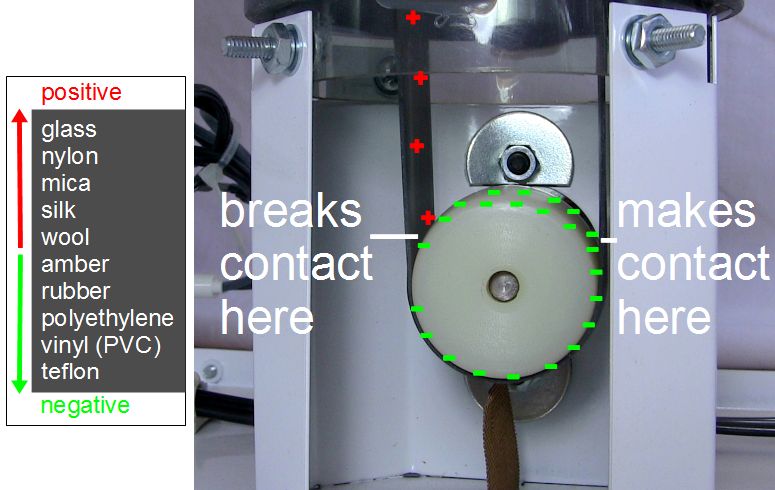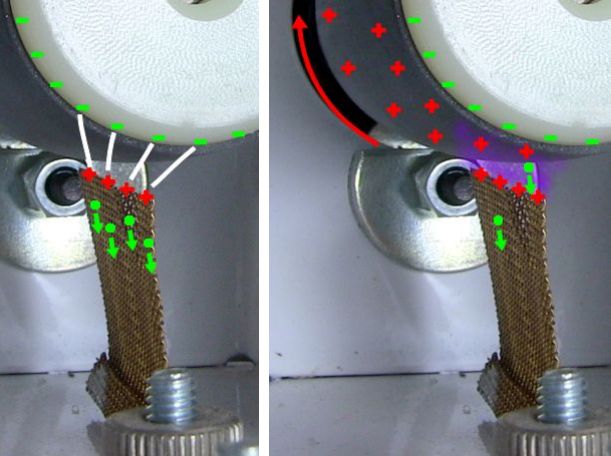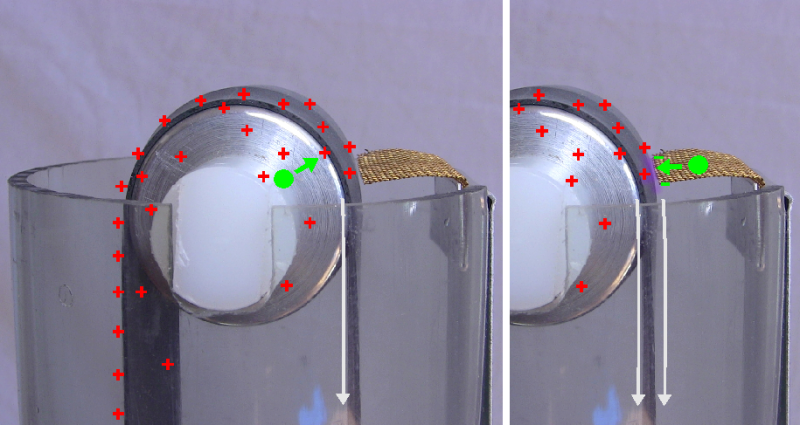What I particularly like about the Van de Graaff (or VDG) is that it’s a combination of a few discrete scientific principles and some mechanically produced current, making it an interesting study. For example, did you know that its voltage is limited mostly by the diameter and curvature of the dome? That’s why a handheld one is harmless but you want to avoid getting zapped by one with a 15″ diameter dome. What follows is a journey through the workings of this interesting high voltage generator.
The Big Picture
The big picture in terms of how a Van de Graaff generator works is that the whole thing acts like an electromechanical pump for electric charge. The outer surface of the belt is charged at the bottom, one side of the belt moves upward, carrying the charge with it, where it’s removed at the top and deposited on the outer surface of the dome.
Before looking at specific areas, here’s a quick look at it as a whole. There’s a roller at the bottom and another roller at the top, both held in place by a cylinder made of a non-electrically conductive material. A belt is wrapped around those rollers with a motor to rotate the bottom roller, moving the belt and in turn rotating the top roller too. The dome encloses the entire mechanism at the top, in this case by sitting on a ring. In the image above, the dome has been removed and is shown upside down so you can see the opening in its bottom.
Very close to the belt at the bottom roller, but not touching it, is a metal brush with sharp points facing the belt. That brush is usually connected to ground, though it could instead go to a second dome as you can see in the handheld Van de Graaff in the image above. Similarly, near the top roller is another brush with sharp points which are close to the belt but not touching. That brush is connected to the dome through contact with a metal plate that sticks out a bit and runs down to the ring that the dome sits on.
Now let’s go through the different areas and electric effects, starting at the bottom.
The Bottom Roller And The Belt

One key thing about the bottom is that as the roller rotates, the outer surface of the roller continuously makes and breaks contact with the inner surface of the belt. Also important are the materials those surfaces are made of. Together this causes the triboelectric effect to take place.
The triboelectric effect is the same effect that gives you a charge when you rub your socks against a carpet, provided the socks and carpet are the right mix of materials. At a molecular level, that rubbing means that contact between molecules is repeatedly being made and broken. When contact is made, electrons are moved from one to the other and when contact is broken, the electrons remain on that side. That leaves one material positively charged and the other negatively charged.
The triboelectric series is a list of materials with the things that become negatively charged on one end of the list and the those that become positively charged on the other end of the list. The further from the middle of the list, the more charged the material will become. In this Van de Graaff generator, the bottom roller’s outer surface is teflon, which is near the negative end. The belt is rubber, which is in the direction of the positive end relative to teflon.
And so with the constant making and breaking of contact at the bottom of the Van de Graaff, the surface of the roller becomes negatively charged while the inner surface of the belt becomes positively charged, but less so since it has a much larger surface area than the roller.
The Belt And The Bottom Brush

But that’s not good enough. We need to charge the outer surface of the belt. That’s where the bottom brush comes in. The negative charge of the roller repels electrons from the brush’s sharp points, making them positive. Whenever you have a charged object with sharp points, the charge is more tightly packed at the points. The end result is a strong electric field near the points.
That strong electric field ionizes the air by ripping electrons from atoms in the air resulting in a bluish corona between the belt and the points. That corona is an area of electrically conductive air, filled with ions and free electrons. Electrons are repelled from the outer surface of the belt and attracted to the brush where they are further repelled to ground. That leaves the outer surface of the belt positively charged.
And since the belt is moving, that positive charge is carried up to the top roller.
The Top Roller And Belt

The top roller is either made of metal or it’s made of a material that’s on the opposite end of the triboelectric series from that of the bottom roller. In this particular Van de Graaff, the top roller is metal. In either case, the end result is the same.
Since both the outer and inner surfaces of the belt are positively charged, electrons come from the metal roller to try to neutralize them, leaving the roller with a built up positive charge and the inner surface of the belt on the way back down with a neutral charge.
The same behavior between the belt and brush at the bottom happens at the top, just with opposite charges. A corona forms in the gap between the surface of the belt and the sharp points of the brush and electrons are pulled from the brush to the surface of the belt, neutralizing the outer surface of the belt. Where do those electrons come from?
Charging The Dome
Those electrons come from the outer surface of the dome. Notice that the top brush is connected to a metal plate that extends down the side of the cylinder where the dome makes electrical contact with it.
The dome acts like a Faraday cage and what happens is the same as happens in Faraday’s ice pail experiment. That experiment demonstrated that any charge deposited on the inside of the dome, or ice pail in Faraday’s case, will end up on the outside of the dome. The inside of the dome will remain neutral. Key here is that since the inside is always neutral, you can keep depositing more and more charge to the inside and there will be no build up of like charge to repel it. Any deposited charge immediately moves to the outside.
And that’s why the voltage limit for a Van de Graaff is determined by the diameter and curvature of the dome. You can keep pumping charge to the dome and it will keep taking it. And just as with the brushes, if the dome had sharp points then it would easily form strong electric fields with the surroundings and form a leaky corona. So the bigger and rounder the dome, the weaker the surrounding electric field will be. It’ll be harder for corona to form and for the surrounding air to become conductive.
There are still limits of course. For example, the electric field between the dome and the grounded parts at the bottom of the Van de Graaff could become strong enough for corona to form, followed by a spark, briefly neutralizing the dome.
But not all Van de Graaff generators come in this shape. We’ve seen one that uses a soda can for the dome and is held in the hand like a wand and another that uses a Christmas tree ornament for the dome. Shocking!
























How efficient is a Van de Graaff generator? Can you charge a bank of capacitors to a high voltage in any reasonable amount of time?
Depends on RPM of your motor, I’m sure there’s a formula out there somewhere. Most demo scale generators spit out into the 100’s of kVs but don’t have any power behind them. The Leyden jars will however create a possibly dangerous situation. E = 0.5 [capacitance] * [voltage]^2 so be careful adding leyden jars to your VDG.
You talk of charging a cap bank as if external capacitance does not increase the max voltage of VDG. How is charging a cap bank any different from two 500kV VDG domes connected by a rod producing 1MV like this https://www.youtube.com/watch?v=xIRGlrwMgKs
I assume max voltage does not increase if VDG dome is connected to regular cap(s), but one might think it does when you look at how capacitance determines the max voltage obtainable by the VDG https://www.youtube.com/watch?v=yaeITv9Ytko
When you consider “The maximal achievable potential is roughly equal to the sphere radius R multiplied by the electric field Emax at which corona discharges begin to form within the surrounding gas. For air at standard temperature and pressure (STP) the breakdown field is about 30 kV/cm.” it is clear why it does not increase.
Or is it
Aside from charge loss by corona, a VDG is quite close to a constant current supply. Usually in the 10ua range from memory. Some have exciters (5kv or so) that spray charge on to the belt instead of friction.
I’ve seen designs where the HV PSU from negative ion generators or copier is used for excitation.
Short answer: no, van de Graaf generators are pretty terrible for power delivery, In terms of the current they deliver, it’s pathetic – microamp scale even in the largest cases. Which, at, say, 1 MV, is like watt scale. And we’re talking about the house-sized van de Graaf generators here. So, yeah. Not good.
There are easy improvements you can make, though – run two generators in parallel, one positive, one negative, to double the voltage difference between them (this is a ‘tandem van de Graaf’). You can replace the belt with a chain of pellets or bars (this is a ‘pelletron’ or ‘laddertron’), which greatly increases the speed you can run them at, and that increases the power delivery.
Accelerators like that are still in service all over the world for physics/medical research, but again, the power delivery isn’t the important part there.
When I was a kid (1960s), I had an absolutely gorgeous, 16″-diameter spun aluminum oblate spheroid for my Van de Graaff generator (it had been a gift, and no doubt an extremely expensive one). To my everlasting misery, at some point when I was away for college it disappeared in a fit of “junk” purging at my parents’ house. Ever since then I’ve wanted to get a replacement to put that painful memory to rest, but haven’t been able to find something even remotely like it. I haven’t had any luck with Google searches, though I suppose it’s possible that I’m not being smart about my search terms. I’ve come up with large metal spheres, but not only do they not look nearly as sexy as an oblate spheroid they also don’t work as well (significantly lower voltage).
Does anyone here know where to find such a thing?
go to local university material sciences department and ask them to make you one?
Oh… never would have thought of that! Thanks. I also just found this: http://www.wenzelmetalspinning.com/aluminum-spinning.html
IKEA’s Blanda Blank (http://www.ikea.com/us/en/catalog/products/00057256/) stainless serving bowls look like pretty nice hemispheres. I’ve bought a few for this purpose but haven’t done anything with them yet.
Yes! I have a homemade VDG using a pair of those and it works really well. On a dry day it will put out 10″ sparks, throw aluminum pie plates or light an LED held in your fingers. It also has a habit of turning EVERYTHING within a few feet into a surprise capacitor.
Check out the link: , I built one in High School for my Science Project and bought the two half spheres from a spun aluminum shop here in Southern California.
http://www.sci-supply.com/Van-De-Graaff-p/lc2910-hc.htm?gclid=Cj0KEQiAuJXFBRDirIGnpZLE-N4BEiQAqV0KGlN8H989lgvdAEePiBvZYng7O12Yk6enKZvsiYaQCU8aAiU88P8HAQ
You might find some relief by discovering “Gazing balls/globes” then.
Turns out huge seamless stainless steel spheres are used as garden ornaments and available on amazon or elsewhere for really cheaper than any custom made counterpart.
16′” size would cost you around 100 bucks.
Try sciencefirst.com . The make and supply material and training for both high school and college science laboratories.
I personally know the current owners who bought the small company called Morris and Lee located in Buffalo NY from the woman’s father Frank Lee after his partner (first name was Morris, can’t remember his last name) passed away.
They grew the company from a little garage style hobby of Frank Lee’s into the company that it is now.
My friend passed away in 2004 from ALS but by then the company was well on its way. The current president is a grandson of Frank Lee, and his mother (Nancy Bell (Lee) and Ray Bell were very close friends of ours for over 35 years.
Following Ray’s death in 2004, Nancy moved the company to Florida where it is now located. They even moved many of the long term employee’s to Florida with them which is something unheard for a relatively small company.
If you do make a contact with them, mention that old friend Dave Struebel told you about them.
Metal spinning is a close cousin to wood-turning. All metal spinners are also decent wood turners as they need to be able make the (positive) shapes to be used as a core. But unfortunately, most of today’s wood-turners shy away from working with metal. There is one exception though: the props department of large theaters as well as companies that make movie props sometimes still have a guy that can turn wood AND spin metal! I used to get my design prototypes from a guy who made 90% of his annual turnover spinning parts for movie productions.
What if any effect does varying the belt length have?
Your machine wil get taller or shorter.
With a longer belt, you’ll be able to have a higher voltage between the dome and the bottom section without sparking between the two ends, though I’ve never had a problem with that, unless you try for a really short belt.
On a really dry day I have had racing sparks on the surface of the tube but charge loss due to dust on the sphere usually limits my setup.
Great explanation and visuals.
Would one get the same charge on the dome using *only* the triboelectric effect, rather than relying on coronas?
Charge has to move, without spraying you’d get a charge separation (of some kilovolts) between the bottom roller and the dome and then run out. By letting the potential between the roller and ground spray charge onto the belt a continuous flow of charge moves up the belt and builds up on the outside of the dome, creating large potentials. I don’t think I’ve ever seen this method work. My memory of the big VdG at our school was it having a metal edge that scraped the belt. This worked very badly most of the time.
Perhaps just because somebody has adjusted it wrongly and the edge was not supposed to scrape the belt?
Could a VDG be built with air flowing through an insulated tube?
The closest thing that I know of would be electrostatic generator where diatomaceous earth or other fine powder is sprayed in cycles through a pipe circuit with compressed air, and charges picked up at the appropriate points.
Basically purposely exploiting the side effects observed in sand blasting cabinets.
I think I saw it in the “Homemade Lightning” book.
I don’t think air flowing through an insulated tube produces a charge. However, air flowing with the right particulates in it can. The triboelectric effect occurs between the particulates hitting and leaving and the inside of the tube. I guess when the particulates get to the dome they’d deposit their charge on the dome. You’d need some way to remove them from the dome afterward, otherwise the dome would fill up. I have no idea how efficient it would be. I guess over time the inside of the tube would become too charged too.
It’s not exactly a VDG, but moving (dry) air can built up strong electric charges. Once I had some impressive sparks (>1cm) from a compressed air pistol used to clean some dusty parts in cold dry winter air.
And my cordless Dyson vacuum cleaner has is charging port in the handle. Now in winter the air in my apartment is very dry. When I use it I feel sparks jumping from the charging socket to my hand. Probably not good for the electronics, but nothing I can do about it.
Dry air flowing in e.g. a PVC pipe can act as a VdG generator without deliberate effort. Woodworking magazines have advised running a conductive wire inside any plastic pipes used as ducting in a woodworking dust extractor.
Worst would be to blow fine [wood]flour in dry air through the plastic pipe at high speed. The discharge would trigger an explosion for quite a range of fuel/air mixes, I suggest. High velocity jagged hard plastic fragments would be potentially lethal. Metal ducting is obviously safer in this regard.
You might be able to use flowing air to move charge sprayed from a multi-kv power supply but I’m not sure how you could get the air out of the sphere without losing charge.
When I was a child I remember a book of advanced physics experiments in the school library, one of which was the construction of a lineartron (that’s right-an atom smasher for kids!) using a VDG, an evacuated tube connecting to the globe diagonally from the floor, a lightbulb filament and I don’t remember what else. Does anyone have the specs on something similar, or an explanation for it as good as this?
Scientific American Amateur Scientist column has 2 that spring to mind, one is an electron accelerator for irradiating seeds and the other is a proton/deuteron accelerator for doing high energy physics, producing high energy gamma rays and neutrons. Do a search for Larry Cress proton deuteron accelerator.
Doing the search led me to here:
http://www.sciencemadness.org/talk/files.php?pid=91439&aid=2765&usg=AFQjCNGoxCCAPv74u-agOGZKtRj52aprhA&bvm=bv.147448319,d.amc
The webpage gives an error but at the same time it still downloads a PDF file with the C L Stong SciAm article.
Lot’s of fun stuff there.
The diagram looks pretty close to that of my 30 year old memory. Thanks guys!
Does the pipe column play a role in the thing ?
I’ve only seen comparatively few VDGs with just plates or pillars as support instead of the pipe column.
Is it just for practclal building reasons ? Or does that enclosed environment play a role in efficiency in any way ?
The pipe is just a very simple way to provide the needed support. The fact that it’s enclosing doesn’t matter. Make sure it’s a non-electrically conductive material though, otherwise it’ll short things out.
When I was a kid (12 years old), my father and I constructed one for the shcool science fair. That ended giving me the first prize in that year.
Thank you so much for writing this up. It comes at a time when I am studying electricity and magnetism, so now I am super interested in building one. Please post content like this more often!
Could you paint the electric charges on a small nylon rope, and use the rope as the belt?
The polarity will be negative if top roller is metal so you got it wrong!!!